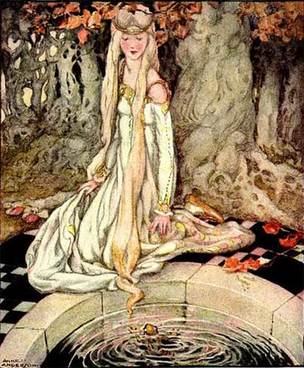|
Ah, yes, the Frog Prince. My first encounter with this story was the 1971 Muppet version and it was absolutely adorable. The versions I read when I was little emphasized the princess being an ungrateful, shallow person who needed to learn to see past appearances. However, the Grimms' early versions (they revised it multiple times) cast a different light on her actions. A slimy, disgusting male wants to sleep with her, and her father's forcing her to agree. It's especially creepy in the versions where she's implied to be very young, crying over a lost toy and so on. She's much more understandable here.
However, it's after disobeying and fighting back that she's rewarded with a prince. In this version she throws him at the wall, but in others she burns his skin or cuts his head off. Violence, not kissing, seems to be the answer to many fairy tale spells. The fox in "The Golden Bird" and the cat in "The White Cat" must have their heads cut off to regain human form, and the lion in "The Wounded Lion" has to be sliced, diced, and set on fire. Doll i' the Grass is accidentally hurled into the river and it seems certain she'll drown. In the Japanese Mamesuke, the titular character's wife tries to drown him. In other versions, the princess just has to share a bed with the frog, a cure that also appears in "East o' the Sun and West o' the Moon." This is a softer and more passive version that paves the way for the now-popular kissing cure. Still, that's a huge step from the transformations that require blood and pain to the transformations via a gentle kiss of true love. There’s also the ending scene with Iron Henry telling the prince that the iron bands around his heart are breaking for joy. I remember that when I read this, despite the explanation, the scene still felt oddly sad to me. Iron Henry also shows up apropos of nothing, despite providing one of the names for the fairytale. Why does such a small character role get so much emphasis? Apparently, Bettelheim said Iron Henry was just there to contrast to the disloyal and promise-breaking princess. However, I think the source material has a better explanation. the Grimms also collected a variant of the tale from Paderborn, where Iron Henry is, well . . . the princess. After the frog prince is cured, the story turns into "East o' the Sun and West o' the Moon," with him wandering off and marrying someone else. The first princess follows after him disguised as a soldier, and the snapping behind the carriage is the sound of her breaking heart, causing him to finally remember her. This makes it seem more like Iron Henry's existence was a garbled version of the original, which can easily happen with oral tales. SOURCES
Text copyright © Writing in Margins, All Rights Reserved
2 Comments
That explanation of Iron Henry makes so much more sense! That scene always seemed so random and puzzling to me.
Reply
Kenneth
4/29/2023 07:24:38 pm
This was Kenyatta and Kahndi Alexander and the guy is here at UGM His name is Curtis Charles Tony Talley Mitchell he the frog that cursed me some how please help me.
Reply
Leave a Reply. |
About
Researching folktales and fairies, with a focus on common tale types. Archives
April 2024
Categories
All
|
Writing in Margins

 RSS Feed
RSS Feed
